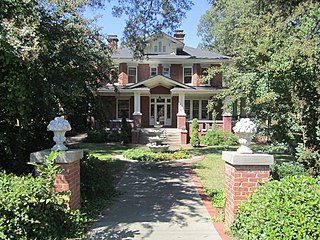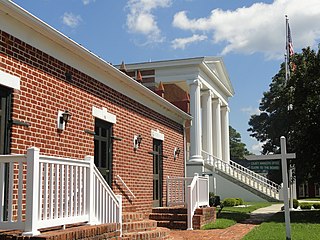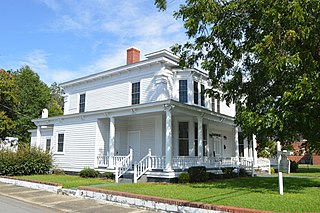
George Walton, a Founding Father of the United States, signed the United States Declaration of Independence while representing Georgia in the Continental Congress. Walton also served briefly as the second chief executive of Georgia in 1779 and was again named governor in 1789–1790. In 1795, he was appointed to the U.S. Senate, to complete the unexpired term of a senator who had resigned.

St. Michael's AnglicanChurch is a historic church and the oldest surviving religious structure in Charleston, South Carolina. It is located at Broad and Meeting streets on one of the Four Corners of Law, and represents ecclesiastical law. It was built in the 1750s by order of the South Carolina Assembly. It is listed on the National Register of Historic Places and is a National Historic Landmark.

The George and Neva Barbee House, also known as the Dr. G. S. Barbee House, is a historic home located at Zebulon, Wake County, North Carolina, a town near Raleigh, NC. Constructed in 1914, the two-story, brick American Foursquare house was designed in the American Craftsman / Bungalow style. It features a hipped roof with overhanging eaves, a porte cochere, a sheltered wraparound porch, and a nearly solid brick porch balustrade.

The Carolina Inn is a hotel listed on the National Register of Historic Places on the campus of the University of North Carolina at Chapel Hill in Orange County, North Carolina, which opened in 1924. The Carolina Inn is a member of Historic Hotels of America, the official program of the National Trust for Historic Preservation.

Gaston Chapel is a historic African Methodist Episcopal church located at 100 Bouchelle Street in Morganton, Burke County, North Carolina. It was built from 1900 to 1911, and is a brick church building with a high-pitched hip roof and Late Gothic Revival style design influences. It features a Gothic-arched tripartite stained-glass window. It is the oldest extant, and first substantial, African-American church structure in Burke County.

Christ Episcopal Church and Parish House is a historic Episcopal church located at 320 Pollock Street in New Bern, Craven County, North Carolina. It was built in 1871, incorporating the brick shell of the previous church built in 1824. It is a brick church building in a restrained Gothic Revival style. It features a three-stage entrance tower, with a pyramidal roof and octagonal spire. Beneath the tower is a Stick Style entrance porch added in 1884. The parish house was built between 1904 and 1908, and is a two-story, three bay by five bay, rectangular red brick building with a steep slate gable roof.

Rue Chapel AME Church is a historic African Methodist Episcopal church located at 709 Oak Street in New Bern, Craven County, North Carolina. It was built in 1941, and is a rectangular brick church building in the Late Gothic Revival style. It features a gabled nave flanked by corner entrance towers. Also on the property is the contributing parsonage; a one-story, front-gable brick house of the American Craftsman style dated to the 1920s.

The General George G. Meade School is a historic elementary/middle school located in the North Central neighborhood of Philadelphia, Pennsylvania, United States.
Charles T. Holt House is a historic home located at Haw River, Alamance County, North Carolina. It was designed by architect George Franklin Barber and built in 1897. The house is a 2+1⁄2-story, rectangular dwelling sheathed in wood, slate, brick and stone in the Queen Anne style. It features peaks, turrets and decorative chimney stacks. Also on the property are the contributing carriage house, servant's quarters, gas house, corn crib, barn, and well house. It was built for textile businessman Charles T Holt, the son of Thomas Michael Holt, governor of North Carolina, and his wife Gena Jones Holt, the daughter of Thomas Goode Jones, governor of Alabama.

Alleghany County Courthouse is a historic courthouse building located at Sparta, Alleghany County, North Carolina. It was built in 1933, and is a two-story, H-shaped Classical Revival style brick building. The front facade features a tetrastyle Tuscan order portico. It was built after "The Big Fire" of 1932 destroyed the courthouse and a block of businesses and homes.

George A. Mears House is a historic home located at Asheville, Buncombe County, North Carolina. It was built about 1885, and is a 2+1⁄2-story, brick Queen Anne style dwelling. It features a number of projecting bass, mansard and garble woofs, and ornamental wraparound verandah.
Swan Ponds is a historic plantation house located near Morganton, Burke County, North Carolina. It was built in 1848, and is a two-story, three-bay, brick mansion with a low hip roof in the Greek Revival style. It features a one-story low hip-roof porch with bracketed eaves, a low pedimented central pavilion, and square columns. Swan Ponds plantation was the home of Waightstill Avery (1741–1821), an early American lawyer and soldier. His son Isaac Thomas Avery built the present Swan Ponds dwelling. Swan Ponds was the birthplace of North Carolina politician and lawyer William Waightstill Avery (1816–1864), Clarke Moulton Avery owner of Magnolia Place, and Confederate States Army officer Isaac E. Avery (1828–1863).

Magnolia Place is a historic home located near Morganton, Burke County, North Carolina. The original section was built about 1818, and is a two-story, five bay by two bay, brick structure in the Federal style. Attached at the rear is a one bay by two bay temple form Greek Revival style addition built about 1850. It features a long full-height porch. The addition was built by Clarke Moulton Avery, second child born to Isaac Thomas Avery, master of Swan Ponds. In 1841, he married Elizabeth Tilghman Walton, daughter of Thomas George Walton, master of Creekside.

Alphonse Calhoun Avery House, also known as the Avery-Surnrnersette House, is a historic home located at Morganton, Burke County, North Carolina. It was built about 1876, and is a two-story, U-shaped, Late Victorian style brick house. It features a 2+1⁄2-story, squarish, brick tower topped by a mansard roof.

Mountain View is a historic plantation house at Morganton, Burke County, North Carolina. It was built about 1815, and is a 2+1⁄2-story, five-bay, Federal-style brick house. It was remodeled in the 1870s in the Gothic Revival style. It features a two-story gabled porch with decorative bargeboards. Later remodelings added Victorian- and Colonial Revival-style decorative elements.

John Alexander Lackey House is a historic home located at Morganton, Burke County, North Carolina. It was built about 1900, and is a two-story, "T"-shaped, gable roofed, brick farmhouse. It has a one-story, gabled kitchen wing. The house features Colonial Revival style detailing.
Duke-Lawrence House, also known as Lawrence House and Shoulars House, is a historic plantation house located near Rich Square, Northampton County, North Carolina. The original western frame section was built about 1747, with the eastern brick section built between 1787 and 1796. It is a "T"-shaped Georgian style dwelling that consists of a 1+1⁄2-story, brick section and the original three bay frame section with a brick end. It features a split-level floor arrangement and a sloping one-story roofline to the rear. The interior woodwork was removed in the 1930s and installed in "Willow Oaks" in Richmond, Virginia.

Northampton County Courthouse Square is a historic courthouse complex located at Jackson, Northampton County, North Carolina. The courthouse was built in 1858, and is a tall one-story, three bay by three bay, Greek Revival style temple-form brick building. It sits on a raised basement and features an imposing prostyle tetrastyle portico with great fluted Ionic order columns. The building was remodeled and a two-story rear addition built in 1939 by the Works Progress Administration. The clerk's and register's office was built in 1831, and is a one-story brick building with stepped parapet gable ends and a plaster cornice. A later clerk's office was built in 1900 between the 1831 building and the courthouse.

Patrick-Carr-Herring House, also known as the Second Sampson County Courthouse, is a historic home located at Clinton, Sampson County, North Carolina. It was built about 1904–1905, and is a two-story, three-bay, double pile, Classical Revival / Greek Revival style frame dwelling with a low-pitched hip roof. It was originally built as a 1+1⁄2-story structure on tall brick piers in 1818, and enlarged to a full two stories in the Greek Revival style on a full one-story brick basement in the 1840s. It was moved to its present site, and remodeled, in 1904–1905, when the current Sampson County Courthouse was constructed. The front features a single-story wraparound porch with Tuscan order columns and bracketing. Also on the property is a contributing smokehouse.





















